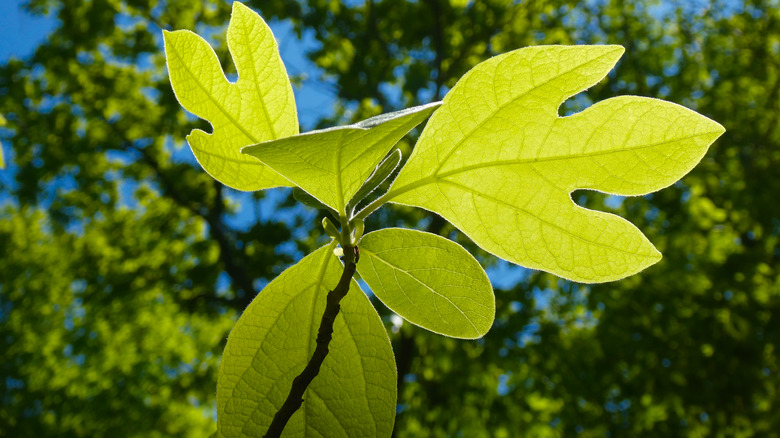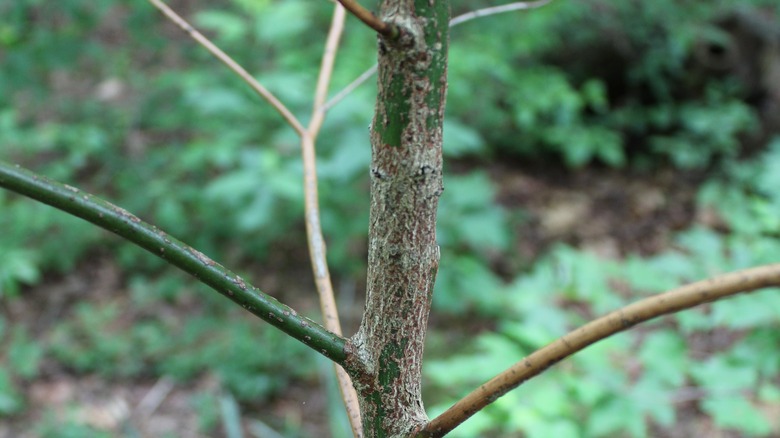Garden Trees, Shrubs & Vines
Jessica Daniels
If you’re familiar with the term “sassafras,” it’s probably in relation to slang describing a brash, sassy person. That’s because back in 1976, the FDA banned the use of the sassafras tree or its components as an ingredient in commercially-produced foods and drugs because of its potentially carcinogenic effects. However, the sassafras tree (Sassafras albidum), used ornamentally in your yard, is a welcome addition that smells delicious, though the scents are quite unique.
This is a shady deciduous tree that naturally creates its own fairy tale thicket for pets and children to frolic in, and its color changes are gorgeously fiery. However, not only is it pretty to look at, but the sassafras tree is also known for its aromatic smells. The leaves, it is said, smell like Froot Loops cereal — a sweet, lemony scent that sparks smiles as well as nostalgia. Meanwhile, the roots are often said to resemble the scent of root beer and the bark of cinnamon. Grow these gorgeous, healthy trees in your yard for a sweet smell and lots of shade.
Follow your nose to the sassafras leaves

ForestSeasons/Shutterstock
Similar to mulberry trees, sassafras trees are native to the United States from southwestern Maine, along the US-Canada border into central Michigan, then south-southwest through Illinois, Iowa, Missouri, Oklahoma, and Texas. They then head east into northern Florida and back north along the Atlantic coast, filling all the space between. Their leaves, which come in three distinct shapes on the same tree, emerge in early spring with a yellowish-green color, deepen in hue slightly over the season, then turn striking shades of red, orange, and purple in the fall. Delightfully, they produce a sweet, citrus scent that many compare to Froot Loops cereal, and it only gets stronger when they are crushed.
For centuries, indigenous cultures have used sassafras leaves both medicinally and as a food additive. They would be made into a poultice and placed directly on cuts, bruises, and even bee stings. The fresh leaves would also be used as a flavor enhancer to dishes, while the dried leaves would be crushed into a powder and used as a thickening agent for soups and stews. While you won’t find sassafras used commercially today, you can still buy crushed or powdered sassafras for use at home in your authentic Creole dinners.
Smells like old fashioned root beer

Sarah Macor/Shutterstock
Every part of sassafras wood has an enticing scent, from the cinnamon-scented bark to the twigs that share the sweet lemon smell of the leaves. But the most well known aroma of sassafras wood is the essence of root beer that comes from its roots. In fact, sassafras root was the original source of root beer. The use of the root has since been forbidden in commercially-sold products because of health concerns, but it’s still possible to harvest for your own personal use.
Indeed, the wood of the sassafras tree, from the deep underground roots to the tiny branches at the top, has often been used in various applications. Kitchen cabinets, split rail posts, and paneling have all been sourced from sassafras trees, among other woodworking projects. Furthermore, their gustatory uses extend far beyond simply root beer. In indigenous communities, the bark and roots were used in medicinal teas. It could be used to treat anything from fevers to cramps and a number of other illnesses. They can also be used to make syrups and kombucha. However, even if you only want a sassafras tree to add an ornamental upgrade to your lawn, plant it in well-drained soil in full to partial sun (preferably dappled) and watch it flourish.



